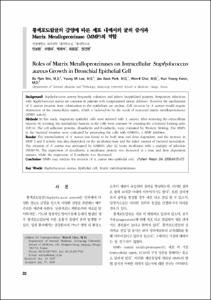KUMEL Repository
1. Journal Papers (연구논문)
1. School of Medicine (의과대학)
Dept. of Internal Medicine (내과학)
황색포도알균의 감염에 따른 세포 내에서의 균의 증식과 Matrix Metalloproteinase (MMP)의 역할
- Keimyung Author(s)
- Park, Jae Seok; Choi, Won Il; Kwon, Kun Young
- Journal Title
- 결핵 및 호흡기 질환
- Issued Date
- 2008
- Volume
- 64
- Issue
- 1
- Abstract
- Background: Staphylococcus aureus frequently colonizes and infects hospitalized patients. Respiratory infections
with Staphylococcus aureus are common in patients with compromised airway defenses. However the mechanisms
of S. aureus invasion from colonization to the epithelium are unclear. Cell invasion by S. aureus would require
destruction of the extracellular matrix, which is believed to be the result of increased matrix metalloproteinases
(MMP) activity.
Methods: In this study, respiratory epithelial cells were infected with S. aureus. After removing the extracellular
bacteria by washing, the internalized bacteria in the cells were assessed by counting the colonized forming units
(CFUs). The cell adhesion proteins, dysadherin and E-cadherin, were evaluated by Western blotting. The MMPs
in the bacterial invasion were evaluated by pretreating the cells with GM6001, a MMP inhibitor.
Results: The internalization of S. aureus was found to be both time and dose dependent, and the increase in
MMP 2 and 9 activity was also dependent on the incubation time and the initial amount of bacterial inoculation.
The invasion of S. aureus was attenuated by GM6001 after 12 hours incubation with a multiply of infection
(MOI)=50. The expression of dysadherin, a membrane protein, was increased in a time and dose dependent
manner, while the expression of E-cadherin was decreased.
Conclusion: MMPs may mediate the invasion of S. aureus into epithelial cells. (Tuberc Respir Dis 2008;64:22-27)
Key Words: Staphylococcus aureus, Epithelial cell, Matrix metalloproteinases
연구배경: 본 연구에서는 황색포도알균이 숙주세포 내
로 침입하여 증식하는 정도를 관찰하고자 한다. 이때 세
포 외 바탕 단백질의 변화가 수반될 것으로 가설을 설정하
고, 이러한 변화에 영향을 미칠 것으로 생각되는 matrix
metalloproteinase (MMP)의 발현과 역할에 대해 연구하
고자 하였다.
방 법: 황색포도알균은 106∼107 CFU/ml을 105개의 기
관지상피세포인 BEAS-2B 세포에 2시간 동안 침입시킨다.
이후 세척으로 세포 밖에 있는 황색포도알균을 제거한 후,
BEAS-2B 세포를 다양한 시간 동안(4, 6, 8, 12 시간) 배양
한 후 황색포도알균의 집락수(CFU/ml)를 측정하였고, 단
백질을 분리하여 세포 외 바탕단백질의 발현 정도와 MMP
의 활성도를 측정하였다. 또한 MMP 억제제인 GM6001을
전처치한 후 황색포도알균을 세포에 침입시킨 후 세포 내
에서의 균의 집락수 및 세포 외 바탕단백질의 변화를 관찰
하였다.
결 과: 황색포도알균의 집락을 측정한 결과 4시간과
12시간을 비교해 볼 때 MOI가 증가할수록, 감염시킨 시간
이 길수록 숙주세포 내로 침입이 유의하게 증가하였다.
BEAS-2B 세포에서 황색포도알균을 침입시킨 시간이 길수
록, MOI가 증가할수록 MMP 2 및 MMP 9의 활성도와 dysadherin의
발현은 증가하였고, 이와는 대조적으로 E-cadherin의
발현은 감소하였다. MMP억제제인 GM6001을 전
처치 한 결과 황색포도알균의 세포 내 침입을 유의하게
감소시켰다.
결 론: 황색포도알균이 기관지 상피세포 내로 침입할 때 dysadherin 및 E-cadherin 같은 세포 외 바탕 단백질의
변화를 동반하며, MMP 활성도가 균의 세포 내 침입에 관
여하는 것으로 보인다.
- Alternative Title
- Roles of Matrix Metalloproteinases on Intracellular Staphylococcus aureus Growth in Bronchial Epithelial Cell
- Publisher
- School of Medicine
- Citation
- 민보람 et al. (2008). 황색포도알균의 감염에 따른 세포 내에서의 균의 증식과 Matrix Metalloproteinase (MMP)의 역할. 결핵 및 호흡기 질환, 64(1), 22–27. doi: 10.4046/trd.2008.64.1.22
- Type
- Article
- ISSN
- 1738-3536
- Appears in Collections:
- 1. School of Medicine (의과대학) > Dept. of Internal Medicine (내과학)
1. School of Medicine (의과대학) > Dept. of Pathology (병리학)
- 파일 목록
-
-
Download
 oak-bbb-00146.pdf
기타 데이터 / 350.38 kB / Adobe PDF
oak-bbb-00146.pdf
기타 데이터 / 350.38 kB / Adobe PDF
-
Items in Repository are protected by copyright, with all rights reserved, unless otherwise indicated.